Numerical and Experimental Analysis of Horizontal-Axis Wind Turbine Blade Fatigue Life
Abstract
:1. Introduction
2. Design of a Turbine Blade
3. Numerical Simulation Models
- Urel = release energy
- P = power,
- c = speed,
- ρ = density
- angle of attack during wind interaction
- B = Blade Number
- CL = Coefficient of Lift
- CD = Coefficient of Drag
4. Results and Discussion
SN Curve
5. Experimental Setup and Specimen Fabrication
6. Experimental Investigation
Uncertainty Calculation
7. Conclusions
- In this research study, the operating system (VDAS) of the SM1090 (Figure 13) is calibrated with ANSYS, and the fatigue life is examined numerically and experimentally while the structure is being built;
- Fatigue failure only happens when the cyclic stresses are greater than the blade material’s yield strength;
- By slowing down the start of cyclic repeated stress, lengthening a blade’s chord immediately extends fatigue life;
- Increasing the leading-edge thickness reduces cyclic stress since it represents the immediate area and lengthens the blade’s fatigue life;
- Because the blade impacts the fraction of deformation, fatigue life relates inversely to blade length; therefore, blade length needs to be less to increase fatigue life;
- The substantial hub stress causes the minimum fatigue life to occur in both blade geometries at the blade root. By extending an airfoil chamber, you can reduce the hub stress propagation and prolong the blade root life fatigue life;
- The failure occurs at a low number of cycles governed by plastic deformation and related to cyclic loads, which is true for both turbine blade designs that experience fatigue.
8. Future Work
- I.
- In the future, a turbine blade’s fatigue behavior will be examined numerically and experimentally, allowing for various points during the blade’s revolution to be analyzed and interpreted.
- II.
- Within a predetermined framework, both the wind and the turbine blades are moving. Further tests may be carried out by using multiple direction loads to verify this numerically and empirically.
Author Contributions
Funding
Institutional Review Board Statement
Informed Consent Statement
Data Availability Statement
Conflicts of Interest
References
- Baqersad, J.; Carr, J.; Lundstrom, T.; Niezrecki, C.; Avitabile, P.; Slattery, M. Dynamic characteristics of a wind turbine blade using 3D digital image correlation. Health Monit. Struct. Biol. Syst. 2012, 8348, 83482I. [Google Scholar]
- Saad, M.M.M. Comparison of Horizontal Axis Wind Turbines and Vertical Axis Wind Turbines. IOSR J. Eng. 2014, 4, 27–30. [Google Scholar] [CrossRef]
- Johari, M.K.; Jalil, M.A.A.; Shariff, M.F.M. Comparison of horizontal axis wind turbine (HAWT) and vertical axis wind turbine (VAWT). Int. J. Eng. Technol. 2018, 7, 74–80. [Google Scholar] [CrossRef] [Green Version]
- Schubel, P.J.; Crossley, R.J. Wind turbine blade design. Energies 2012, 5, 3425–3449. [Google Scholar] [CrossRef] [Green Version]
- Chao, D.; Yongjian, S. Working process of steam turbine and establishment of start-up model. Int. J. Phys. Res. Appl. 2021, 4, 39–47. [Google Scholar] [CrossRef]
- Amanraj. Research Paper on Study of Air Intake System. 2015. Available online: https://vdocuments.site/research-paper-on-study-of-steam-turbine-paper-on-study-of-steam-turbine-amanraj.html (accessed on 4 July 2022).
- Aziz, S.; Khan, A.; Shah, I.; Khan, T.A.; Ali, Y.; Sohail, M.U. Computational Fluid Dynamics and Experimental Analysis of a Wind Turbine Blade’s Frontal Section with and without Arrays of Dimpled Structures. Energies 2022, 15, 7108. [Google Scholar] [CrossRef]
- Mazur, Z.; Luna-Ramírez, A.; Juárez-Islas, J.A.; Campos-Amezcua, A. Failure analysis of a gas turbine blade made of Inconel 738LC alloy. Eng. Fail. Anal. 2005, 12, 474–486. [Google Scholar] [CrossRef]
- Hwang, W.; Han, K.S. Cumulative Damage Models and Multi-Stress Fatigue Life Prediction. J. Compos. Mater. 1986, 20, 125–153. [Google Scholar] [CrossRef]
- Kammouna, Z.; Briffaut, M.; Malecot, Y. Experimental Study of the Creep Effect on the Mechanical Properties of Concrete. Adv. Civ. Eng. 2019, 2019, 5907923. [Google Scholar] [CrossRef]
- Mander, J.B.; Panthaki, F.D.; Kasalanatp, A. Low-Cycle Fatigue Behavior of Reinforcing Steel. J. Mater. Civ. Eng. 1994, 6, 453–468. [Google Scholar] [CrossRef]
- International Association of Journals & Conferences. Joint International Conference on Engineering and Related Technologies (4: 2014: Orlando) and International Society of Agile Manufacturing. In Proceedings of the Joint International Conference on Engineering and Related Technologies (4: 2014: Orlando), 4th IAJC/ISAM Conference Proceedings, IAJC, Orlando, FL, USA, 25–27 September 2014. [Google Scholar]
- Kumar, A.; Khan, M.Z.U.; Pandey, B. Wind Energy: A Review Paper. Gyancity J. Eng. Technol. 2018, 4, 29–37. [Google Scholar] [CrossRef]
- Industry, L. Self-Adapting Wind Turbine Blades Numerical Approach and Optimization. Available online: https://doiserbia.nb.rs/Article.aspx?ID=0354-98361904397C (accessed on 23 March 2019).
- Shohag, M.A.S.; Hammel, E.C.; Olawale, D.O.; Okoli, O.I. Damage mitigation techniques in wind turbine blades: A review. Wind Eng. 2017, 41, 185–210. [Google Scholar] [CrossRef]
- Cui, W. A state-of-the-art review on fatigue life prediction methods for metal structures. J. Mar. Sci. Technol. 2002, 7, 43–56. [Google Scholar] [CrossRef]
- Gao, H. The Theory of Materials Failure. Mater. Today 2014, 17, 94–95. [Google Scholar] [CrossRef]
- Zhu, S.P.; Yue, P.; Yu, Z.Y.; Wang, Q. A combined high and low cycle fatigue model for life prediction of turbine blades. Materials 2017, 10, 698. [Google Scholar] [CrossRef] [Green Version]
- Schweizer, C.; Seifert, T.; Nieweg, B.; Von Hartrott, P.; Riedel, H. Mechanisms and modelling of fatigue crack growth under combined low and high cycle fatigue loading. Int. J. Fatigue 2011, 33, 194–202. [Google Scholar] [CrossRef]
- Issler, S.; Roos, E. Numerical and experimental investigations into life assessment of blade-disc connections of gas turbines. Nucl. Eng. Des. 2003, 226, 155–164. [Google Scholar] [CrossRef]
- Krish, N.; Nehru, K.; Asokan, R. Low Cycle Fatigue Analysis of Gas Turbine Blade Cfd Analysis View Project Cfd Analysis of Tandem Winged Aircraft View Project Low Cycle Fatigue Analysis of Gas Turbine Blade. Available online: https://www.researchgate.net/publication/313530025 (accessed on 12 June 2023).
- Classical, R.B.Y. Improving the design of a wind turbine blade. In Proceedings of the 2014 International Conference on Production Research—Regional Conference Africa, Europe and the Middle East 3rd International Conference on Quality and Innovation in Engineering and Management, Cluj-Napoca, Romania, 1–5 July 2014. [Google Scholar]
- Irfan, M.; Shah, I.; Niazi, U.M.; Ali, M.; Ali, S.; Jalalah, M.S.; Asif Khan, M.K.; Almawgani, A.H.M.; Rahman, S. Numerical analysis of non-aligned inputs M-type micromixers with different shaped obstacles for biomedical applications. Proc. Inst. Mech. Eng. Part E J. Process Mech. Eng. 2022, 236, 870–880. [Google Scholar] [CrossRef]
- Shah, I.; Kim, S.W.; Kim, K.; Doh, Y.H.; Choi, K.H. Experimental and numerical analysis of Y-shaped split and recombination micro-mixer with different mixing units. Chem. Eng. J. 2019, 358, 691–706. [Google Scholar] [CrossRef]
- Shah, I.; Su Jeon, H.; Ali, M.; Yang, D.H.; Choi, K.-H. Optimal parametric mixing analysis of active and passive micromixers using Taguchi method. Proc. Inst. Mech. Eng. Part E J. Process Mech. Eng. 2019, 233, 1292–1303. [Google Scholar] [CrossRef]
- Khan, A.; Shah, I.; Aziz, S.; Waqas, M.; Khaleeq, U. Numerical and Experimental Analysis of Drag and Lift Forces on a Bullet Head. Aerospace 2022, 9, 816. [Google Scholar] [CrossRef]
- Khan, A.; Shah, I.; Gul, W.; Khan, T.A.; Ali, Y. Numerical and Experimental Analysis of Shell and Tube Heat Exchanger with Round and Hexagonal Tubes. Energies 2023, 16, 880. [Google Scholar] [CrossRef]
- Campbell, J. Sixty Years of Casting Research. Metall. Mater. Trans. A Phys. Metall. Mater. Sci. 2015, 46, 4848–4853. [Google Scholar] [CrossRef]
- Falco, M. Design, Testing, and Analysis of a Novel Fatigue Testing Apparatus. Master’s Thesis, University of Rhode Island, Kingston, RI, USA, 2011. [Google Scholar]

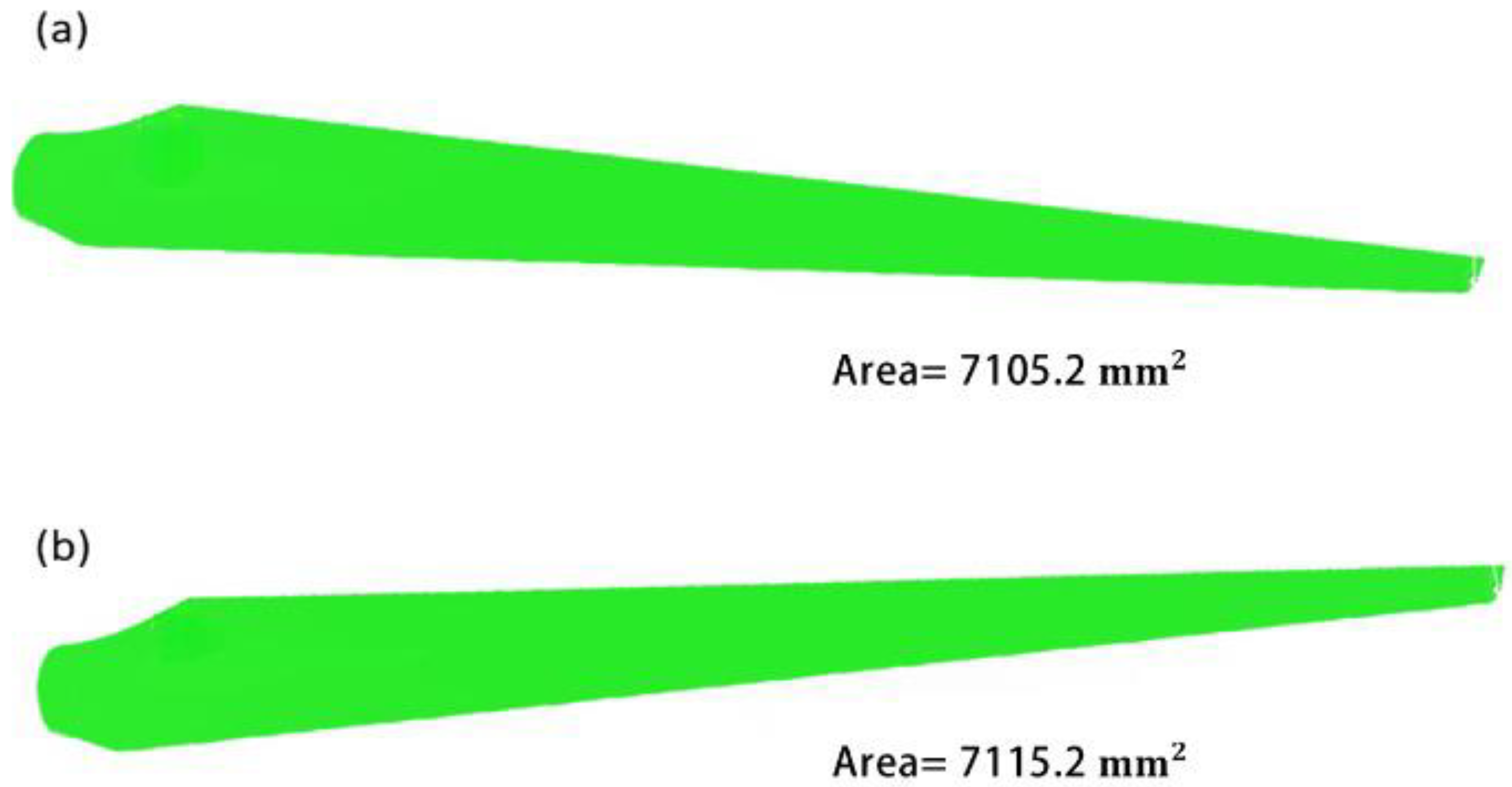
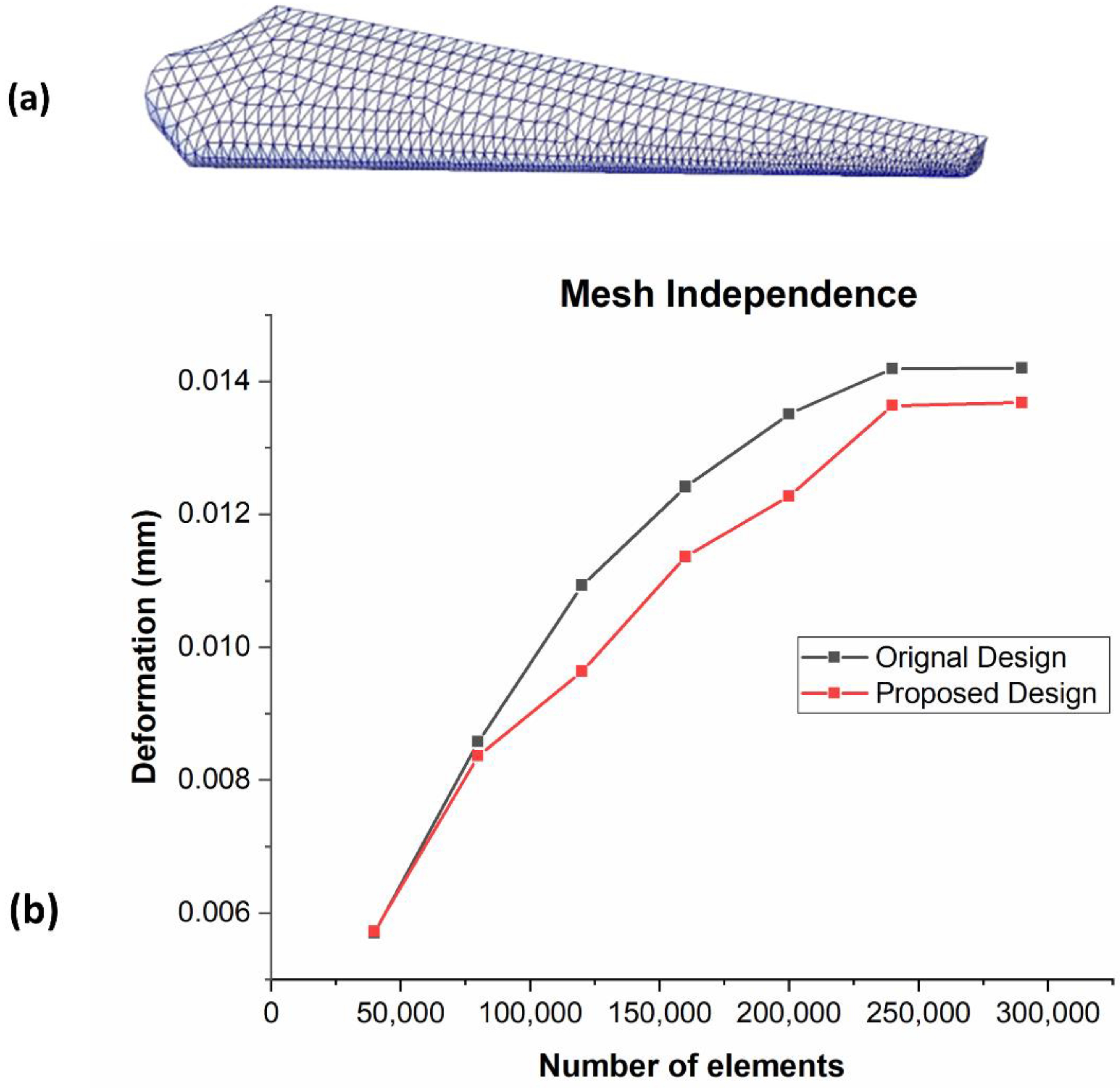

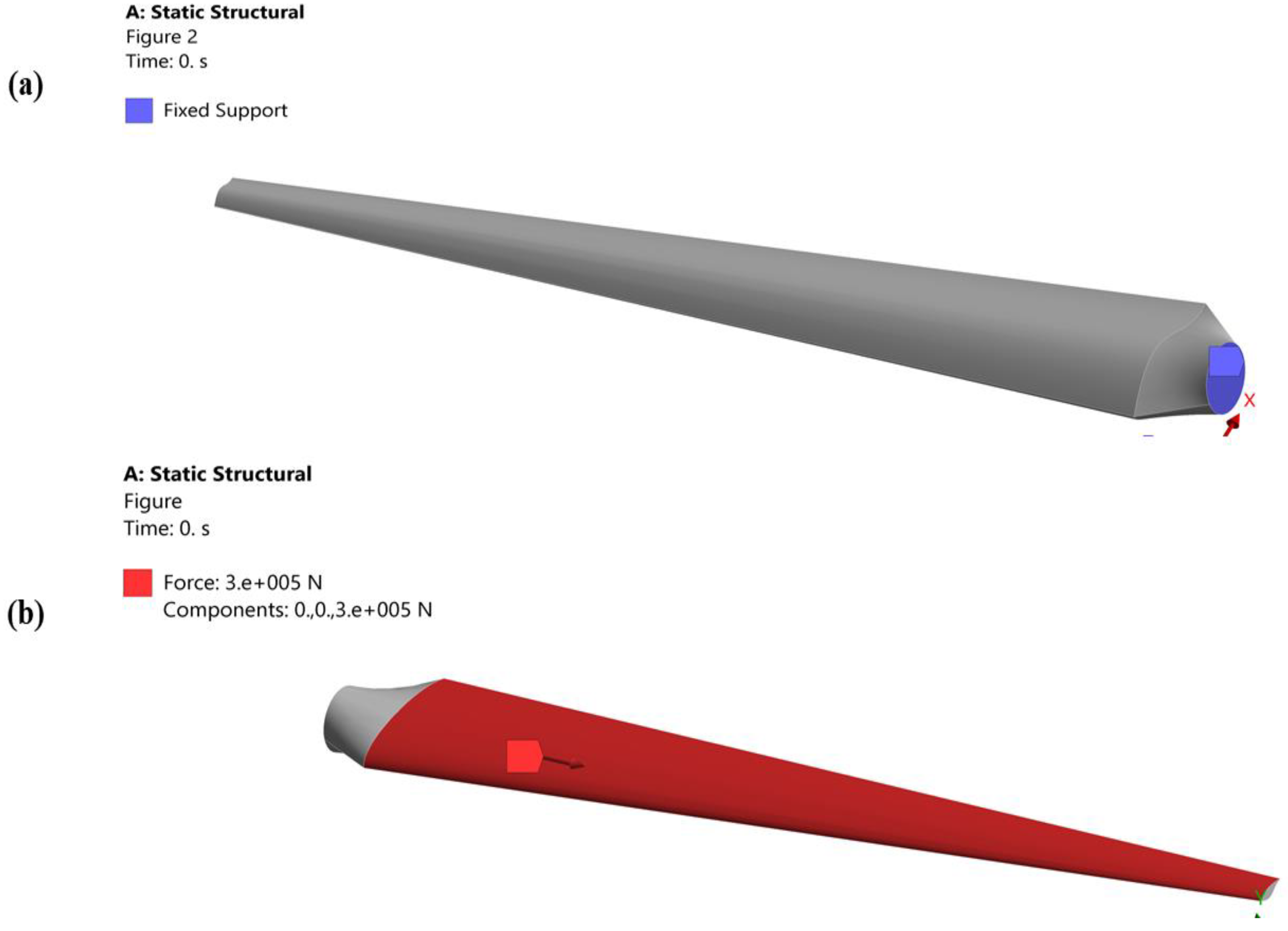
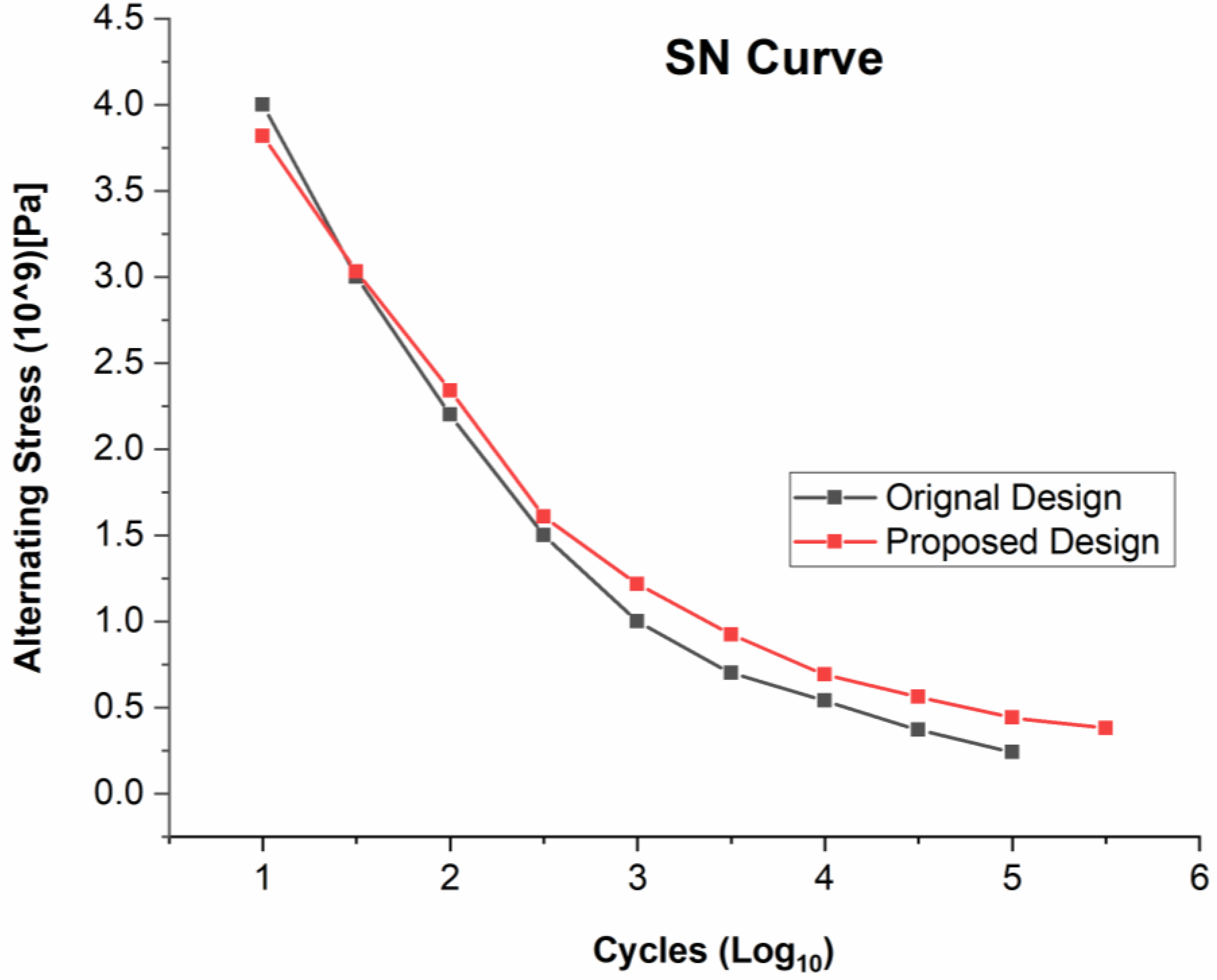


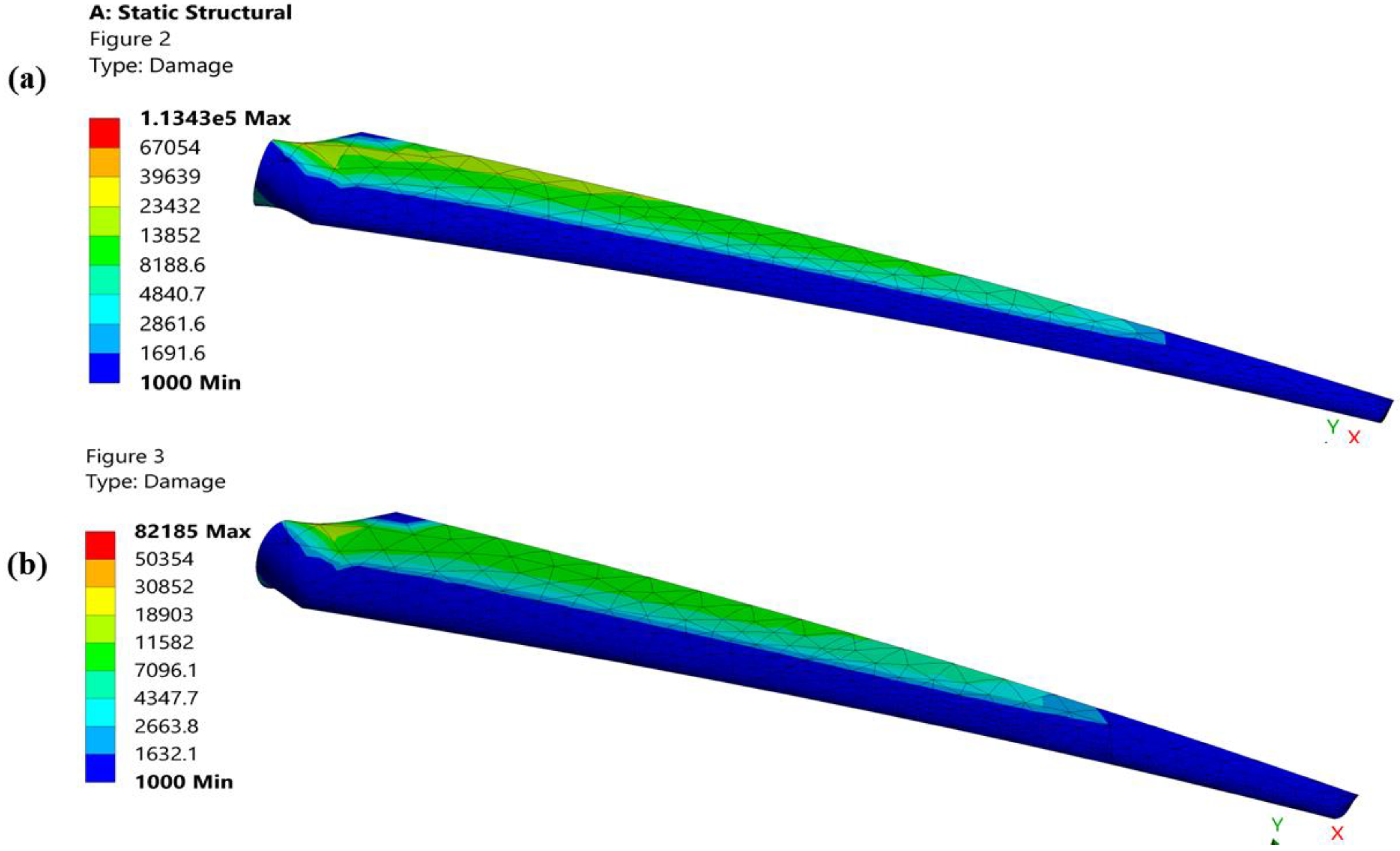
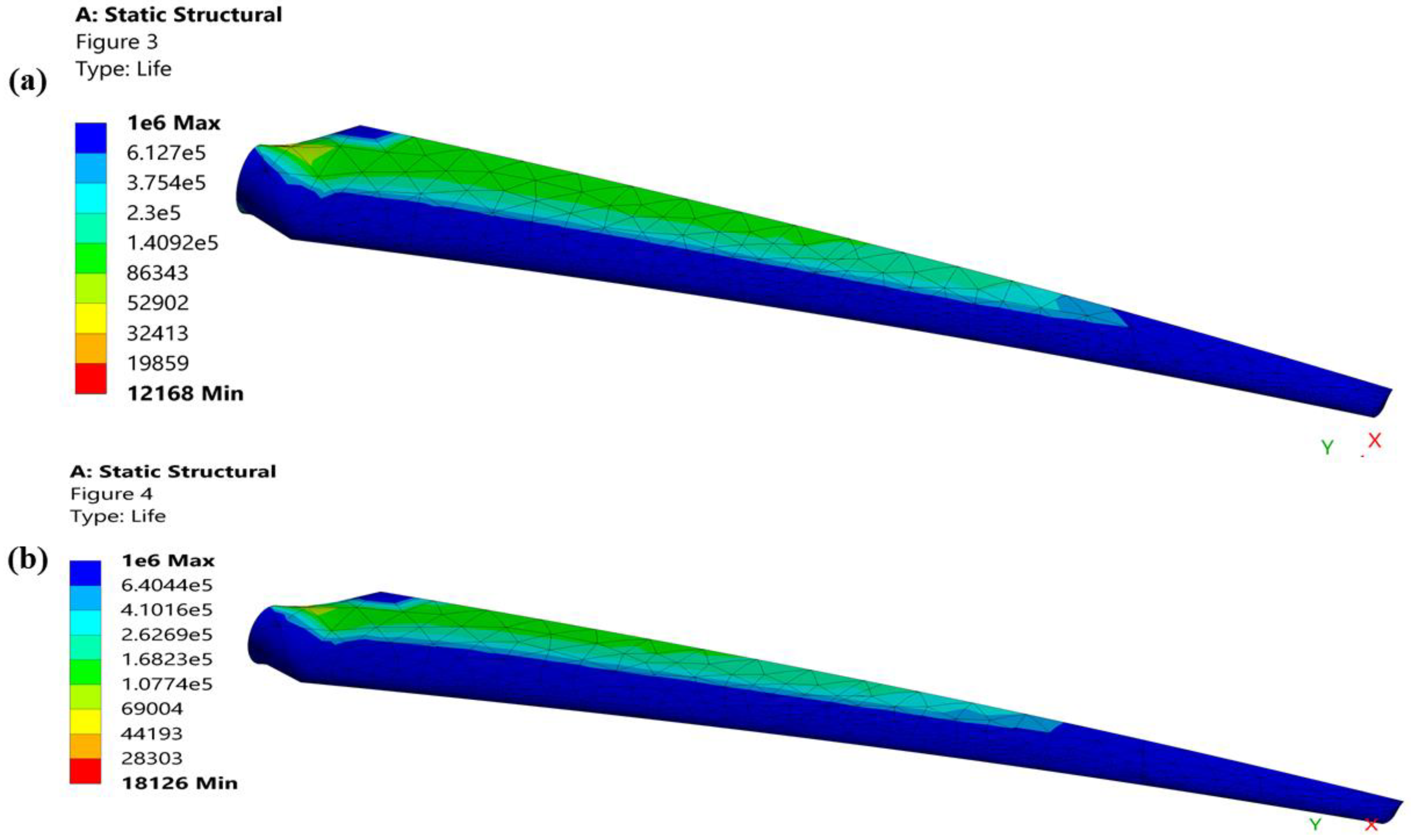



| S.NO | Mechanical Properties | Value |
|---|---|---|
| 01 | Density | 2.7 g/cm3 |
| 02 | Ultimate Strength | 990 Mpa |
| 03 | Yield Strength | 240 Mpa |
| 04 | Modulus of elasticity | 70 Gpa |
| 05 | Fatigue Strength | 510 Mpa |
| 06 | Poisson Ratio | 0.33 |
| 07 | Melting Point | 660 °C |
| 08 | Fatigue Limit range | 0.06–0.1 |
| 09 | Fatigue strength factor | 01 |
| Original Design | Proposed Design |
|---|---|
| Numerical Consideration | Numerical Consideration |
| Minimum Fatigue life = FL = 12,168 | Minimum Fatigue life = FL = 18,126 |
| Experimental Consideration | Experimental Consideration |
| Minimum Fatigue life = FL = 12,182 | Minimum Fatigue life = FL = 18,183 |
| Percentage Uncertainty | Percentage Uncertainty |
|
|
Disclaimer/Publisher’s Note: The statements, opinions and data contained in all publications are solely those of the individual author(s) and contributor(s) and not of MDPI and/or the editor(s). MDPI and/or the editor(s) disclaim responsibility for any injury to people or property resulting from any ideas, methods, instructions or products referred to in the content. |
© 2023 by the authors. Licensee MDPI, Basel, Switzerland. This article is an open access article distributed under the terms and conditions of the Creative Commons Attribution (CC BY) license (https://creativecommons.org/licenses/by/4.0/).
Share and Cite
Shah, I.; Khan, A.; Ali, M.; Shahab, S.; Aziz, S.; Noon, M.A.A.; Tipu, J.A.K. Numerical and Experimental Analysis of Horizontal-Axis Wind Turbine Blade Fatigue Life. Materials 2023, 16, 4804. https://doi.org/10.3390/ma16134804
Shah I, Khan A, Ali M, Shahab S, Aziz S, Noon MAA, Tipu JAK. Numerical and Experimental Analysis of Horizontal-Axis Wind Turbine Blade Fatigue Life. Materials. 2023; 16(13):4804. https://doi.org/10.3390/ma16134804
Chicago/Turabian StyleShah, Imran, Abdullah Khan, Muhsin Ali, Sana Shahab, Shahid Aziz, Muhammad Adnan Aslam Noon, and Javed Ahmad Khan Tipu. 2023. "Numerical and Experimental Analysis of Horizontal-Axis Wind Turbine Blade Fatigue Life" Materials 16, no. 13: 4804. https://doi.org/10.3390/ma16134804







